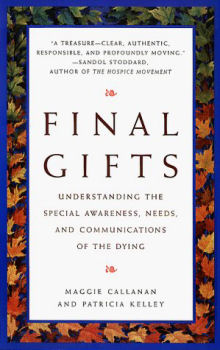
|
Posted October 10, 2005
Book: Final Gifts: Understanding the special awareness, needs, and communications of the dying Authors: Maggie Callanan, and Patricia Kelley Simon and Schuster, NY, pp. 239 An Excerpt from the Jacket:
For more than a decade hospice nurses Maggie Callanan and Patricia Kelley have tended the terminally ill. Now, in this moving and compassionate book, they share their intimate experiences with patients at the edge of life. Through these stories you’ll come to appreciate the near-miraculous ways in which the dying communicate their needs, reveal their feelings, and even choreograph their own final moments; you’ll gain new insights into the leave-taking process, and in the end you’ll discover the gifts – of wisdom, faith, and love – that the dying leave for us to share. An Excerpt from the Book: At the core of each such message is the news that dying people know they are dying – perhaps before anyone else. Instead of anxiety, that knowledge may be accompanied by a need for information about the process of dying or concern for those they love. Simple, brief, and concise information helps to allay those fears. The family’s reassurances — that they’ll be all right and they know what’s going on — often bring the peace a dying person needs. If possible, such comfort should come directly from the family; if impossible, a third party can — and should — attempt to reassure and comfort the individual. Table of Contents: I. Nearing death awareness: Introduction and background 2. Nearing death awareness 3. Beginnings 4. Reactions to death II. Nearing death awareness: what I am experiencing 5. “Where’s the map?” 6. Preparing for travel or change: “I’m getting ready to leave.” 7. Being in the presence of someone not alive: “I’m not alone.” 8. Seeing a place: “I see where I’m going.” 9. Knowing when death will occur: “It will be when. . . “ III. Nearing Death Awareness: What I need for a peaceful death 10. “We must go to the park.” 11. Needing reconciliation: “I need to make peace with. . . 12. Being held back: “I’m stuck in between. . . .” 13. Nonverbal communications: “My actions speak for me.” 14. Symbolic dreams: “I dreamed about. . .” 15. Choosing a time: “The Time is right.” 16. Nearing death awareness: Practical uses |
|
